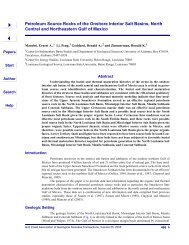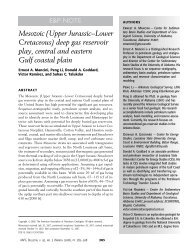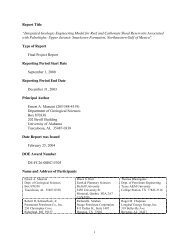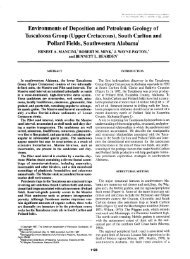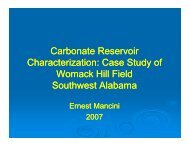Part 4 - Berg - Hughes Center
Part 4 - Berg - Hughes Center
Part 4 - Berg - Hughes Center
Create successful ePaper yourself
Turn your PDF publications into a flip-book with our unique Google optimized e-Paper software.
system that includes a variety of depositional environments associated with the transition<br />
from the continental braided stream deposits to shallow-marine carbonate shelf deposits<br />
of the overlying Sligo Formation.<br />
Zimmerman and Goddard (2001), studying an area that includes parts of and extends<br />
to the south of the basin, reported there were four wells that completely penetrate the<br />
formation. The penetrations are located in a shallower shelf area along the eastern margin<br />
of the Sabine Uplift in Sabine and Natchitoches Parishes. These four wells provide facies<br />
control for the updip portion of the Hosston Formation. Farther downdip, deeper water<br />
facies were interpreted in the eight wells found to have penetrated the entire upper half of<br />
the Hosston interval. These eight wells, located in the deeper part of the study area, plus<br />
one additional well that penetrated the lower Hosston Formation in extreme southwest<br />
Mississippi, provide the main control for understanding deeper water Hosston deposition.<br />
It is noted that there are no known conventional cores available from any of the downdip<br />
wells, and the depositional environments are based on well-log interpretations. However,<br />
two wells, one updip in Red River Parish and one in Zwolle field, located in Sabine<br />
Parish, just southeast of the Sabine Uplift, encountered a shaly facies with Bossier-like<br />
lithology. Based on that data and a detailed facies interpretation, Zimmerman and<br />
Goddard (2001) concluded that depositional environments in the downdip area were<br />
deeper water and quite different from those found in the shallower updip Hosston.<br />
In the past, in order to evaluate the hydrocarbon potential of the Hosston in<br />
unexplored areas, an attempt was made to predict what sort of environment might have<br />
existed for this formation in the deeper, sparsely drilled parts of the basin (Cullom et al.,<br />
1962). It was determined from sandstone-limestone percentage maps that some of the<br />
362




